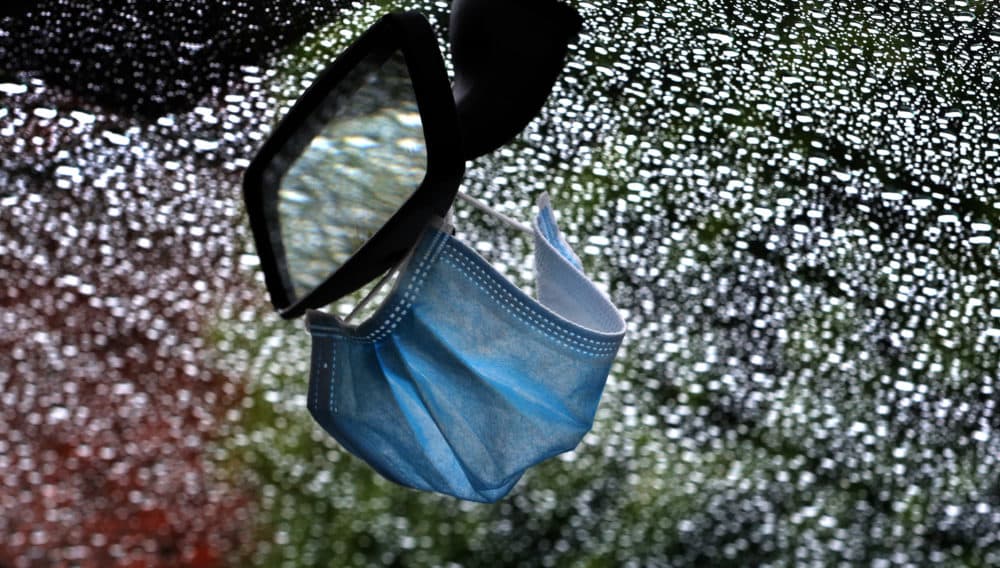Advertisement
Coronavirus Coverage
How To Navigate The 'New Normal' Of The Pandemic, According To Experts

If the pandemic was a wildfire raging across the state in March and April, these days it’s sputtering along with scattered embers and small fires here and there. The positive test rate for coronavirus in Massachusetts has fluctuated under 1% for the last month and recently ticked up to just over that mark. Still, public officials say, for the most part, the preventive measures put in place to curb the spread of COVID-19 seem to be working.
But the virus is still out there, and there are still many things researchers are learning about how it spreads, and how to live with the threat of COVID-19.
“The ‘new normal’ — we’re there,” says Dr. Shira Doron, a hospital epidemiologist at Tufts Medical Center. “We have learned that you can open things and do much of what you used to do with masks and distances — outdoor and indoor dining, movies, some of the stuff that we wondered if we could ever do again.”
WBUR spoke with Doron and other health experts about what’s changed in the last six months and put together a list of essential things to know about living in “the new normal.”
The Centers for Disease Control and Prevention put out and quickly retracted guidance that said the SARS-CoV2 virus is airborne. What does that mean, and is the coronavirus airborne?
Doron: In epidemiology, when we say “airborne” we talk about diseases that travel on air for long distances, and all of them have a certain [spreading rate]. The coronavirus is not like that. An airborne infection would have a household transmission rate of close to 100%. And this disease has a transmission rate of usually less than 20% [in the same household].
In experiments, you can show with a rotating drum that you can aerosolize or suspend particles of this virus for longer periods of time and for more than six feet. And there can be close-range aerosols. That’s where the confusion comes from.
But the coronavirus is not airborne. It’s not a debate. The strategies we use for droplet transmission are masking and good ventilation, and that works for the coronavirus.
So, the word airborne was very unexpected to me [on the CDC page]. I wasn’t surprised to see it come down.
Advertisement
Editor's Note: After this story published, the CDC again updated its guidance on coronavirus transmission. The agency now says the virus can sometimes be spread by exposure to airborne droplets and particles, particularly in poorly ventilated spaces. The CDC adds that while this is airborne transmission, it is uncommon, and the coronavirus typically spreads through close contact.
The average positive test rate in Massachusetts has been below 1% for a while. Does that mean we’re safe now and can go about our everyday lives?
Doron: A caveat is that we can never depend on just one metric – it has to be the whole big picture, not just percent positives.
We can’t sustain [the low numbers] if we just go back to acting like we did in January. There’s absolutely no question. Israel got to a much better place than Massachusetts and is on a vertical upslope now – that’s what happens when you think you can pat yourself on the back and go back to normal behavior. So, we can’t do that. We have to keep our guard up for ourselves and everybody else.
But we can open up and do things like indoor and outdoor dining. Will you be at zero risk with masks and distances and low numbers in your community? No. We will not get to a zero risk for a really, really long time, if ever. It’s everybody’s individual decision how much they want to participate in the things that society is now offering.
What sorts of things are you doing in your everyday life now? Eating at restaurants? Going to gyms? What’s safe to do?
Doron: I err on the side of outdoor dining but will go to an indoor restaurant. I’ve gathered within groups outside in a big backyard — like as many as 25 [people]. Indoors, less than 10. I haven’t been to a movie theater or a gym, but I am working all the time right here in the hospital.
Dr. Yonatan Grad, epidemiologist at Harvard University: The ideal time to travel or see people was over the summer, when case counts were so low in this area and weather was accommodating. I didn’t travel, but I was seeing people and having meals outdoors. I hadn’t been doing that in the spring. It’s going to be a concern as we move into colder weather and becomes harder to have social time with people outdoors.
When do you think you’ll be able to go back to doing things like we did before the pandemic?
Barry Bloom, epidemiologist at Harvard University: That’s going to be a long time. Until there’s rapid testing, and everybody can test themselves on a regular basis and has the will to lock themselves up if there’s a possibility they’ve been recently infected – I think we’re going to be in a different state for a long time with or without a vaccine.
Doron: Possibly not ever. This virus certainly could be around forever in small pockets.
What do we know about asymptomatic transmission now?
Doron: It does happen. But there hasn’t been proven transmission after day six of getting infected, even though someone can stay positive for 30 days or more. So, the vast majority of asymptomatic positive cases are no longer contagious by the time they’re tested.
Should I worry about my kids going to school? What do we know about kids and how they spread coronavirus?
William Hanage, epidemiologist at Harvard University: There’s a lot of confusion on how children spread COVID-19. We don’t know how much transmission happens in schools because we haven’t studied them in sufficient depth. It’s unclear if young children are less likely to spread the virus — although teenagers do spread the virus, same as adults. Schools will provide some contribution to COVID-19 transmission, but it’s obviously the case that it is safe for schools to reopen when community transmission is low.
People used to wash their groceries, but now it seems there’s little evidence that grocery bags are a vector. What’s a reasonable level of precaution, given what we know about the coronavirus now?
Doron: I’ve never recommended people wash their grocery bags. Certainly people who are more vulnerable should still be more careful. Personally, I think it’s much more effective and makes more sense to clean your hands when you’ve handled something that’s been handled by somebody else. Having your hands clean before you touch your face or eat is always the best defense and a good lifelong habit.
We don’t think that objects are a huge factor in transmitting the infection, although we see people all the time that say they can’t imagine where they got it, they don’t even go anywhere. I don’t know what that means.
Is testing a reliable way to make sure you are able to do things safely like travel, see friends, etc?
Doron: In short, no. If you get tested for coronavirus, that’s a snapshot in time. It’s less likely that I’ll have the virus on Tuesday if I got a negative result on Monday, but it doesn’t preclude that I have the virus on Tuesday. That’s part of the problem with the testing platforms we have now. You have to have the results by the time you do that visit to grandma, but you have to get it so far in advance that it becomes less and less relevant.
My son joked that if you got a test 10 days before, and it was positive, then he could definitely go visit grandma because you’re no longer infectious after 10 days.
If I already tested positive for the coronavirus and recovered, does that mean I’m safe now?
Doron: We really hoped that would be the case, but there have been demonstrated cases of reinfection, and one was in less than 90 days. But just one in the millions and millions of cases seen worldwide, so it’s extremely rare to have reinfection within two months of infection.
Being able to spend social time outdoors has been a boon to people’s moods recently. What do you think the winter will be like? How can we keep our mental health up during those months?
Karestan Koenen, psychiatric epidemiologist at Harvard University: This is something that’s been on my mind a lot recently. There are a few practical things: You should plan ahead. For instance, a lot my friends who were never really outdoorsy people are buying a lot of outdoor winter gear now. I bought an outdoor heater for my porch so that we might still be able to have some outdoor social time here.
One thing to do is find some really concrete positive things and remind yourself of them. For example, one thing I like about working from home is that I don’t have to rush and get everyone out of the house in the morning. Another thing you can do is positive event scheduling – put positive things in your day concretely. So, it can be as simple as, I’m going to take a call on my cellphone and walk outside if it’s sunny. I’m going to turn my phone off and watch a TV show with my kids at this time.
Is a second wave really coming?
Grad: It’s important to remember that our experience with the pandemic is very much dependent on our choices. When we see a rise in cases, that’s really a reflection of us providing an opportunity for the virus to transmit. It’s not like weather patterns or waves in the ocean, where they came at some predictable pattern. Right now, there’s an increase in cases that may be attributable to a couple things — most prominently the start of in-person classes in universities and having people come from around the country.
We don’t know if there will be another surge in cases. We can anticipate some rise based on movement towards opening different parts of the economy — restaurants and bars and so on — that will help accelerate spread. But ultimately, it depends on us and what we do this winter.
If there is a second wave, will our lives go back to the way they were in April with everything getting shut down and everyone staying at home?
Grad: It depends on how widespread the cases are and how quickly they’re detected. If we can identify where cases are taking place with testing, we may be able to proceed with much more localized interventions and increased monitoring. I think we [can do that]. There’s always room for improvement, but [testing and surveillance] infrastructure is certainly better than it was back in the spring, and the number of cases is far lower. That makes monitoring and interventions much easier to interact.
Doron: I think it’s unlikely that we’ll see something like we did in April, which was out of control spread. Masking and distancing are so much more effective than we even thought it would be. The evidence suggests we don’t need to go back to a total shutdown phase. We showed that we can continue to bring cases down as we reopen businesses — and it wasn’t businesses that caused cases. It was human behavior.
This article was originally published on September 28, 2020.
